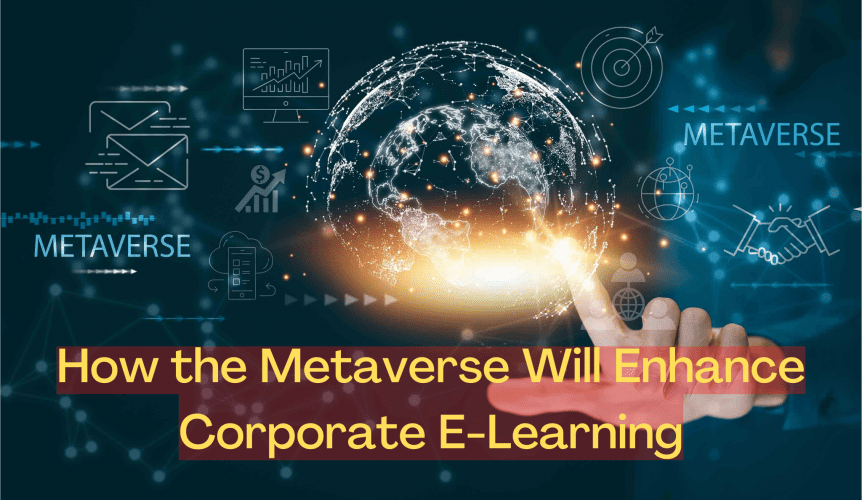How the Metaverse Will Enhance Corporate E-Learning
It has been possible to learn using a digital device for decades. What has changed is the technologies that are available. The first big change was the internet, as it enabled e-learning content to be distributed digitally as well as consumed digitally. The increasing use of mobile devices in e-learning was another big change, as it broke the cable, i.e., it meant e-learning courses no longer needed to be completed on a computer. Will the metaverse be the next big development in e-learning?
The metaverse as a concept has been around for some time. Games like Roblox and Minecraft are forms of the metaverse. That said, there is now an increased level of interest in the metaverse following recent investment announcements by companies like Meta (Facebook) and Microsoft.
Given the popularity of existing forms of the metaverse and the push by big tech companies to further evolve the concept, it is worth exploring the role the metaverse is likely to play in corporate e-learning.
What is the Metaverse?
There are many definitions for the metaverse, but the simplest is that it involves interacting using avatars in a virtual space. Those interactions could be with real people, virtual avatars, and objects, both virtual and real.
For example, in the metaverse, your avatar could go to an art gallery, chat with other real people who are also visiting (via their avatars), interact with virtual staff at the museum, and look at paintings that exist in the real world but have been recreated in the metaverse. You might even be able to click on a link within the metaverse that takes you to an ecommerce store where you can purchase the real painting.
In other words, the metaverse involves blurring the virtual and real-world, where real-world interactions take place in a virtual space.
5 Ways the Metaverse Will Impact E-Learning
Taking the last point above a step further, those real-world interactions could be training and learning experiences. Here are five ways the metaverse will impact e-learning.
1. Creates More Immersive Experiences
The main benefit of the metaverse is that it is more immersive than other online and digital experiences. You can move where you want to, for example, look where you want, interact with who you want, and customise your avatar how you want.
Creating immersive experiences is often an objective when developing e-learning courses, as you want to draw the learner into the topic as much as possible. The metaverse will help with this.
2. Creates More Realistic Experiences
The training you provide for your team should be as realistic as possible. This means presenting realistic situations and ensuring the content you present in the course is relevant to the day-to-day experience of learners.
For example, when you create a scenario element in your e-learning course, the situation should be something the learner will recognise.
The metaverse allows you to make the experiences you create for learners even more realistic. You can even do this for situations where it is difficult or even impossible to make realistic in the real world.
A dangerous situation in the real world, for example, can be experienced safely by learners in the metaverse. Similarly, a situation that would be too expensive to create as a learning experience in the real world could be replicated cost-effectively in the metaverse.
There are multiple examples of this currently in use today – examples that can be loosely connected to the metaverse. Racing car drivers honing their skills in advanced simulators from their living rooms is one example. Another is a surgeon using virtual reality to train students in a different location.
3. Blurs the Line Between Classroom-Based Training and Online Training
While the advantages of e-learning greatly outweigh the disadvantages, one of the downsides is that it can be difficult to replicate the human-to-human interaction that is part of classroom-based training. As a result, completing an e-learning course is often a largely solitary exercise.
The metaverse can turn this on its head, as it combines both person-to-person interactions and digitalised training delivery. So, you can create a virtual classroom as part of an e-learning course in the metaverse where learners can interact with each other and their trainers.
4. Enhances Engagement
One of the main ways the metaverse is currently being used is in the gaming world. This has benefits for e-learning, as the metaverse will create new opportunities for developing gamification elements in courses.
Gamification is generally considered to have a positive impact on engagement rates and the learner experience, so enhancing the use of gamification via the metaverse should improve outcomes even further.
5. Improved Use of Data
The digital nature of the metaverse means there is the potential to collect and assess even more data than is currently possible with traditional e-learning methods. This enhanced access to data can improve decision-making at a training strategy level, while also helping to improve individual learning experiences.
A Technical Reality Today
For many people, particularly those who work outside the tech sector, the metaverse is a concept that will become available at some time in the future. It is true the various technologies that will make up the metaverse are still evolving. In some cases, the technologies are still being developed.
However, there are technologies that exist today that make it possible for organisations to take their first steps into the metaverse with e-learning. Therefore, offering your team training courses that are delivered via the metaverse might be closer than you think.
